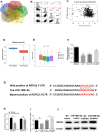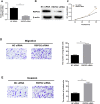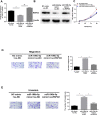miR-196b-5p Promotes Proliferation, Migration and Invasion of Lung Adenocarcinoma Cells via Targeting RSPO2
- PMID: 33402849
- PMCID: PMC7778444
- DOI: 10.2147/CMAR.S274171
miR-196b-5p Promotes Proliferation, Migration and Invasion of Lung Adenocarcinoma Cells via Targeting RSPO2
Abstract
Objective: To explore the biological role of miR-196b-5p/RSPO2 in the occurrence and development of lung adenocarcinoma (LUAD) and to provide a basis for finding new therapeutic targets for LUAD.
Methods: Differentially expressed genes were analyzed based on LUAD microarray, and the target gene of the target miRNA was predicted. qRT-PCR was used to detect the expression levels of miR-196b-5p and RSPO2 mRNA in normal human bronchial epithelial cell line BEAS-2B and LUAD cell lines A549, NCI-H1792 and NCI-H226. Western blot was used to evaluate protein expression. Cell proliferative, migratory and invasive abilities were detected by CCK-8 and transwell assays. Dual-luciferase assay was conducted to verify the targeting relationship between miR-196b-5p and RSPO2.
Results: The results of qRT-PCR showed that miR-196b-5p was significantly highly expressed in LUAD cells, and the expression level of its downstream target gene RSPO2 was significantly decreased. The results of CCK-8 and transwell assays exhibited that miR-196b-5p promoted proliferation, migration and invasion of LUAD cells, while RSPO2 inhibited the malignant progression of LUAD cells. Dual-luciferase assay confirmed the targeted binding relationship between miR-196b-5p and RSPO2. Overexpression of RSPO2 partially reversed the promotion of miR-196b-5p on proliferation, migration and invasion of LUAD cells.
Conclusion: miR-196b-5p promoted proliferation, migration and invasion of LUAD cells by targeting and down-regulating RSPO2, which provided ideas for searching new targets for the diagnosis and treatment of LUAD.
Keywords: RSPO2; invasion; lung adenocarcinoma; miR-196b-5p; proliferation.
© 2020 Xu and Xu.
Conflict of interest statement
The authors report no conflicts of interest for this work.
Figures





Similar articles
-
MiR-196b Promotes the Invasion and Migration of Lung Adenocarcinoma Cells by Targeting AQP4.Technol Cancer Res Treat. 2021 Jan-Dec;20:1533033820985868. doi: 10.1177/1533033820985868. Technol Cancer Res Treat. 2021. PMID: 33455522 Free PMC article.
-
miR-186-5p promotes cell growth, migration and invasion of lung adenocarcinoma by targeting PTEN.Exp Mol Pathol. 2019 Jun;108:105-113. doi: 10.1016/j.yexmp.2019.04.007. Epub 2019 Apr 11. Exp Mol Pathol. 2019. PMID: 30981721
-
CircPRKCI regulates proliferation, migration and cycle of lung adenocarcinoma cells by targeting miR-219a-5p-regulated CAMK1D.Eur Rev Med Pharmacol Sci. 2021 Feb;25(4):1899-1909. doi: 10.26355/eurrev_202102_25085. Eur Rev Med Pharmacol Sci. 2021. PMID: 33660800
-
miR-139-5p Inhibits Lung Adenocarcinoma Cell Proliferation, Migration, and Invasion by Targeting MAD2L1.Comput Math Methods Med. 2020 Nov 4;2020:2953598. doi: 10.1155/2020/2953598. eCollection 2020. Comput Math Methods Med. 2020. Retraction in: Comput Math Methods Med. 2023 Sep 27;2023:9789647. doi: 10.1155/2023/9789647. PMID: 33204298 Free PMC article. Retracted.
-
RBM15 facilities lung adenocarcinoma cell progression by regulating RASSF8 stability through N6 Methyladenosine modification.Transl Oncol. 2024 Aug;46:102018. doi: 10.1016/j.tranon.2024.102018. Epub 2024 Jun 4. Transl Oncol. 2024. PMID: 38838436 Free PMC article. Review.
Cited by
-
RSPO2 as Wnt signaling enabler: Important roles in cancer development and therapeutic opportunities.Genes Dis. 2023 Apr 19;11(2):788-806. doi: 10.1016/j.gendis.2023.01.013. eCollection 2024 Mar. Genes Dis. 2023. PMID: 37692504 Free PMC article. Review.
-
Epigenetic Alterations of DNA Methylation and miRNA Contribution to Lung Adenocarcinoma.Front Genet. 2022 May 31;13:817552. doi: 10.3389/fgene.2022.817552. eCollection 2022. Front Genet. 2022. PMID: 35711943 Free PMC article.
-
Vitamin D deficiency inhibits microRNA-196b-5p which regulates ovarian granulosa cell hormone synthesis, proliferation, and apoptosis by targeting RDX and LRRC17.Ann Transl Med. 2021 Dec;9(24):1775. doi: 10.21037/atm-21-6081. Ann Transl Med. 2021. PMID: 35071469 Free PMC article.
-
Prospects of microRNAs as therapeutic biomarkers in non-small cell lung cancer.Med Oncol. 2023 Nov 3;40(12):345. doi: 10.1007/s12032-023-02212-5. Med Oncol. 2023. PMID: 37922117 Review.
-
Combination therapy with budesonide and N-acetylcysteine ameliorates LPS-induced ALI by attenuating neutrophil recruitment through the miR-196b-5p/Socs3 molecular axis.BMC Pulm Med. 2022 Oct 26;22(1):388. doi: 10.1186/s12890-022-02185-7. BMC Pulm Med. 2022. PMID: 36289489 Free PMC article.
References
-
- Casali C, Rossi G, Marchioni A, et al. A single institution-based retrospective study of surgically treated bronchioloalveolar adenocarcinoma of the lung: clinicopathologic analysis, molecular features, and possible pitfalls in routine practice. J Thorac Oncol. 2010;5:830–836. doi:10.1097/jto.0b013e3181d60ff5 - DOI - PubMed
LinkOut - more resources
Full Text Sources

